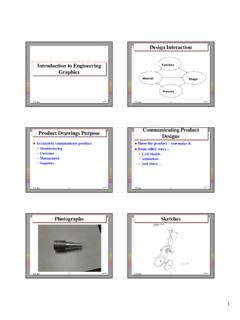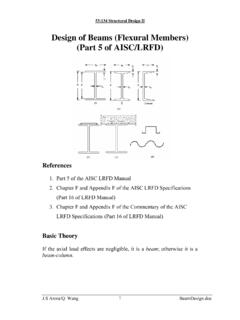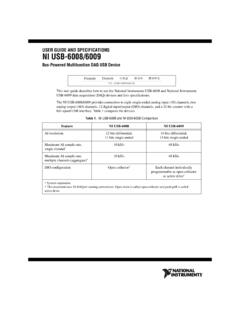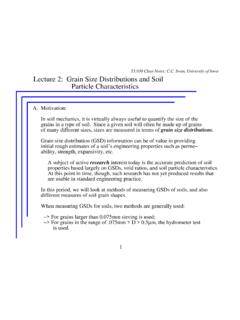Transcription of 56:171 Operations Research Final Examination Solutions
1 Solutions56:171 Operations ResearchFinal Exam '98page 1 of 14tststst 56:171 Operations Researchtststststststs Final Examination Solutionsstststtststst Fall 1998tststst Write your name on the first page, and initial the other pages. Answer both Parts A and B, and 4 (out of 5) problems from Part A:Miscellaneous multiple choice20 Part B:Sensitivity analysis (LINDO)20 Part C:1. Discrete-time Markov chains I152. Discrete-time Markov chains II153. Continuous-time Markov chains154. Decision analysis155. Dynamic programming15total possible:100tststst PART A tstststMultiple Choice: Write the appropriate letter (a, b, c, d, or e) : (NOTA =None of the above)._e__1. If, in the optimal primal solution of an LP problem (min cx st Ax b, x 0), there is zero slack in constraint #1, thenin the optimal dual solution,a.
2 Dual variable #1 must be zeroc. slack variable for dual constraint #1 must be zerob. dual variable #1 must be positived. dual constraint #1 must be slacke. NOTA_c__2. If, in the optimal solution of the dual of an LP problem (min cx subject to: Ax b, x 0), dual variable #2 ispositive, then in the optimal primal solution,a. variable #2 must be zeroc. slack variable for constraint #2 must be zero b. variable #2 must be positived. constraint #2 must be slack e. NOTA_b__ 3. If Xij>0 in the transportation problem, then dual variables U and V must satisfya. Cij > Ui + Vjc. Cij < Ui + Vje. Cij = Ui - Vjb. Cij = Ui + Vj d. Cij + Ui + Vj = 0 f. NOTA_c__ 4. For a discrete-time Markov chain, let P be the matrix of transition probabilities.
3 The sum of column is 1c. row is 1b. column is 0d. row is 0e. NOTA_b__ 5. In PERT, the completion time for the project is assumed toa. have the Beta distributionc. be constantb. have the Normal distributiond. have the exponential distributione. NOTA_b__ 6. In an M/M/1 queue, if the arrival rate = > = service rate, thena. = 1 in steady statec. i > 0 for all ie. the queue is not a birth-death processb. no steady state existsd. = 0 in steady statef. NOTA_d__7. If there is a tie in the "minimum-ratio test" of the simplex method, the solution in the next tableaua. will be nonbasicc. will have a worse objective value a. will be nonfeasible d. will be degenerate e. NOTA_d__ 8. An absorbing state of a Markov chain is one in which the probability ofa.
4 Moving into that state is zeroc. moving into that state is moving out of that state is moving out of that state is zeroe. NOTAThe problems (9)-(12) below refer to the following LP:(with inequalities converted to equations:)Minimize 8X1 + 4X2 Minimize 8X1 + 4X2subject to 3X1 + 4X2 6subject to 3X1 + 4X2 - X3 = 6 5X1 + 2X2 10 5X1 + 2X2 + X4 = 10 X1 + 4X2 4 X1 + 4X2 +X5 = 4 X1 0, X2 0Xj 0, j=1,2, 3,4,5 Solutions56:171 Operations ResearchFinal Exam '98page 2 of 14_a__9 .The feasible region includes pointsa. B, F, & Gc. C, E, & Fb. A, B, C, & Fd. E, F, &G e.
5 NOTA_d__10. At point F, the basic variables include the variablesa. X2 & X3c. X4 & X5b. X3 & X4d. X1 & X4 e. NOTA__b_11. Which point is degenerate in the primal problem?a. point Ac. point Cb. point Bd. point D e. NOTA_c__12. The dual of this LP has the following constraints (not including nonnegativity or nonpositivity):a. 2 constraints of type ( )b. one each of type & c. 2 constraints of type ( )d. one each of type & =e. None of the above_b__13. The dual of the LP has the following types of variables:a. three non-negative variablese. three non-positive variablesb. one non-negative and two non-positive variablesf. None of the abovec. two non-negative variables and one unrestricted in signd.
6 Two non-negative variables and one non-positive variable_e__14. If point F is optimal, then which dual variables must be zero, according to the Complementary SlacknessTheorem ?a. Y1 and Y2d. Y1 onlyb. Y1 and Y3e. Y2 onlyc. Y2 and Y3f. Y3 onlyConsider a discrete-time Markov chain with transition probability matrix :. If the system is initially in state #1, the probability that the system will be in state 2 after exactly one step is:a. none of the aboveb. 16. If the Markov chain in the previous problem was initially in state #1, the probability that the system will still be instate 1 after 2 transitions isa. 0e. NOTAS olutions56:171 Operations ResearchFinal Exam '98page 3 of 14_c_17.
7 The steady-state probability vector of a discrete Markov chain with transition probability matrix P satisfies thematrix equationa. P = 0c. (I-P) = 0e. NOTAb. P = d. Pt = 0_a_ 18. For a continuous-time Markov chain, let be the matrix of transition rates. The sum of each ..a. row is 0c. row is 1e. NOTAb. column is 0d. column is 1_e_ 19. To compute the steady state distribution of a continuous-time Markov chain, one must solve (in addition to sumof components equal to 1) the matrix equation (where t is the transpose of ):a. = 1c. T = e. = 0b. T = 1d. = f. NOTA_e_ 20. Little's Law is applicable to queues of the class(es):a. M/M/1c. any birth-death processe. any queue with steady stateb.
8 M/M/c for any cd. any continuous-time Markov chainf. NOTA_e_ 21. In a birth/death model of a queue,a. time between arrivals has Poisson distributionb. number of "customers" served cannot exceed 1c. the distribution of the number of customers in the system has exponential distributiond. the arrival rate is the same for all statese. None of the abovetststst PART B tstststSensitivity Analysis in LP. "A manufacturer produces two types of plastic cladding. These have the trade names Ankalor and Beslite. One yard ofAnkalor requires 8 lb of polyamine, lb of diurethane and 2 lb of monomer. A yard of Beslite needs 10 lb of polyamine, 1lb of diurethane, and 4 lb of monomer. The company has in stock 80,000 lb of polyamine, 20,000 lb of diurethane, and30,000 lb of monomer.
9 Both plastics can be produced by alternate parameter settings of the production plant, which is able toproduce sheeting at the rate of 12 yards per hour. A total of 750 production plant hours are available for the next planningperiod. The contribution to profit on Ankalor is $10/yard and on Beslite is $20 company has a contract to deliver at least 3,000 yards of Ankalor. What production plan should be implemented in orderto maximize the contribution to the firm's profit from this product division."Definition of variables: A = Number of yards of Ankalor producedB = Number of yards of Beslite producedLP model:1) Maximize 10 A + 20 B subject to 2) 8 A + 10 B 80,000 (lbs. Polyamine available)3) A + 1 B 20,000 (lbs.
10 Diurethane available)4)2 A + 4 B 30,000 (lbs. Monomer available)5) A + B 9,000 (lbs. Plant capacity)6) A 3,000 (Contract)A 0, B 0 The LINDO solution is:OBJECTIVE FUNCTION VALUE1) VALUE REDUCED COSTA SLACK OR SURPLUS DUAL PRICES2) ) ) ) ) :171 Operations ResearchFinal Exam '98page 4 of 14 RANGES IN WHCH THE BASIS IS UNCHANGEDOBJ COEFFICIENT RANGESVARIABLECURRENT ALLOWABLE ALLOWABLECOEF INCREASE DECREASEA INFINITY SIDE RANGESROW CURRENT ALLOWABLE ALLOWABLERHSINCREASEDECREASE2 TABLEAUROW(BASIS) ABSLK 2 SLK 3 SLK 4 SLK +062 . the LINDO output above to answer the following questions. If there is not sufficient information in the LINDO output, answer "NSI".


![Corrosion Protection.ppt [Read-Only] - University of Iowa](/cache/preview/1/c/f/9/2/e/d/5/thumb-1cf92ed5cf903dbf2b6cd3a840081a01.jpg)






